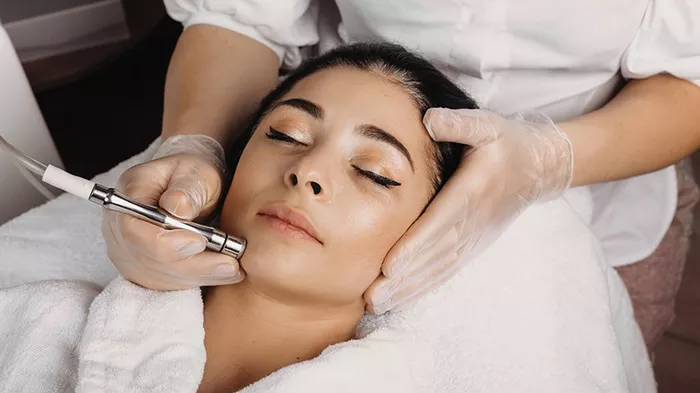Microdermabrasion is a popular cosmetic procedure that can help improve the appearance of scars. Whether you have acne scars, surgical scars, or other types of scars, microdermabrasion offers a non-invasive and effective option for scar reduction. In this article, we will explore how microdermabrasion works, its effectiveness in treating scars, and the considerations to keep in mind when seeking this treatment.
Understanding Microdermabrasion
Microdermabrasion is a non-surgical procedure that exfoliates the outermost layer of the skin to reveal a smoother and more even complexion. It involves the use of a handheld device that sprays fine crystals or utilizes a diamond-tipped wand to gently remove the dead skin cells. Simultaneously, a vacuum-like suction mechanism helps remove the exfoliated skin and debris.
The exfoliation process stimulates collagen production and promotes cell turnover, leading to improved skin texture, reduced fine lines, and diminished scars. Microdermabrasion is generally safe for most skin types and can be performed on the face, neck, chest, hands, and other areas of the body.
How Microdermabrasion Helps Scars
Microdermabrasion can help improve the appearance of scars through several mechanisms:
-
Exfoliation
By removing the outer layer of dead skin cells, microdermabrasion helps to smooth the skin’s surface and reduce the visibility of scars. It can effectively target surface-level scars, such as acne scars or shallow surgical scars.
-
Collagen Stimulation
Microdermabrasion stimulates collagen production, which is crucial for healthy and resilient skin. Increased collagen can help fill in depressed scars and improve their overall appearance over time.
-
Enhanced Absorption
After microdermabrasion, the skin becomes more receptive to topical treatments and skincare products. This allows for better penetration of scar-reducing creams, serums, or other treatments that can be applied after the procedure. The combination of microdermabrasion and targeted topical treatments can enhance the scar reduction process.
Effectiveness and Limitations of Microdermabrasion for Scars
Microdermabrasion is most effective for treating superficial scars and those that are close to the surface of the skin. It can help reduce the visibility of scars caused by acne, minor injuries, or mild surgical procedures. However, it may have limitations for more severe or deep scars, such as extensive burn scars or deep acne scars.
It’s important to have realistic expectations when considering microdermabrasion for scar treatment. While it can improve the appearance of scars and make them less noticeable, it may not completely eliminate deep or indented scars. In some cases, a combination of microdermabrasion with other treatments like chemical peels, laser resurfacing, or dermal fillers may be necessary to achieve optimal results for more complex scars.
Considerations for Microdermabrasion for Scars
Before undergoing microdermabrasion for scar treatment, it’s essential to consider the following:
-
Scar Type
Microdermabrasion is best suited for superficial scars. If you have deep or extensive scars, it’s advisable to consult with a skincare professional to determine the most appropriate treatment approach.
-
Skin Sensitivity
Microdermabrasion may cause mild discomfort or temporary redness, particularly for individuals with sensitive skin. It’s important to discuss any concerns or underlying skin conditions with your skincare professional before proceeding with the treatment.
-
Treatment Plan
The number of microdermabrasion sessions required to see noticeable improvements in scars can vary depending on factors such as scar type, size, and location. Discuss your specific situation with a skincare professional who can create a tailored treatment plan to address your scars effectively.
-
Combination Approaches
In some cases, combining microdermabrasion with other scar treatment modalities can enhance results. Your skincare professional may recommend combining microdermabrasion with chemical peels, laser resurfacing, or dermal fillers to address different aspects of scar appearance, such as texture, color, or depth.
-
Post-Treatment Care
Following microdermabrasion, it’s important to follow your skincare professional’s post-treatment care instructions. This may include avoiding sun exposure, applying sunscreen, and using gentle skincare products. Proper care can help optimize results and minimize the risk of complications.
-
Maintenance and Longevity
While microdermabrasion can provide noticeable improvements in scar appearance, maintenance treatments may be necessary to sustain the results. Your skincare professional can advise you on the recommended frequency of maintenance sessions based on your individual needs.
Consultation with a Skincare Professional
Before undergoing microdermabrasion for scar treatment, it’s crucial to consult with a qualified skincare professional. They will evaluate your specific scar type, assess the severity, and recommend the most suitable treatment plan. During the consultation, be sure to communicate your expectations, concerns, and any previous treatments or skincare products you have used.
Cost Considerations
The cost of microdermabrasion for scar treatment can vary depending on various factors, including the location of the clinic, the expertise of the skincare professional, and the number of sessions required. On average, a single microdermabrasion session in Canada ranges from $100 to $200. However, multiple sessions may be necessary to achieve desired results, and package deals or discounts may be available at some clinics.
It’s important to prioritize the expertise and reputation of the skincare professional over the cost alone. Choosing a qualified professional who specializes in scar treatment can help ensure both safety and effectiveness.
Conclusion
Microdermabrasion is a non-invasive cosmetic procedure that can help improve the appearance of scars by exfoliating the skin, stimulating collagen production, and enhancing the absorption of scar-reducing topical treatments. It is particularly effective for superficial scars and can provide noticeable improvements in scar texture and visibility.
However, it’s important to have realistic expectations and understand that microdermabrasion may have limitations for deep or extensive scars. Consulting with a skincare professional is essential to determine the most appropriate treatment plan and address any concerns or questions you may have.
Consider factors such as scar type, skin sensitivity, treatment plan, combination approaches, post-treatment care, and the expertise of the skincare professional. By understanding these considerations and discussing them with a qualified professional, you can make informed decisions about microdermabrasion for scar treatment and take a step towards achieving smoother, more even-looking skin.


